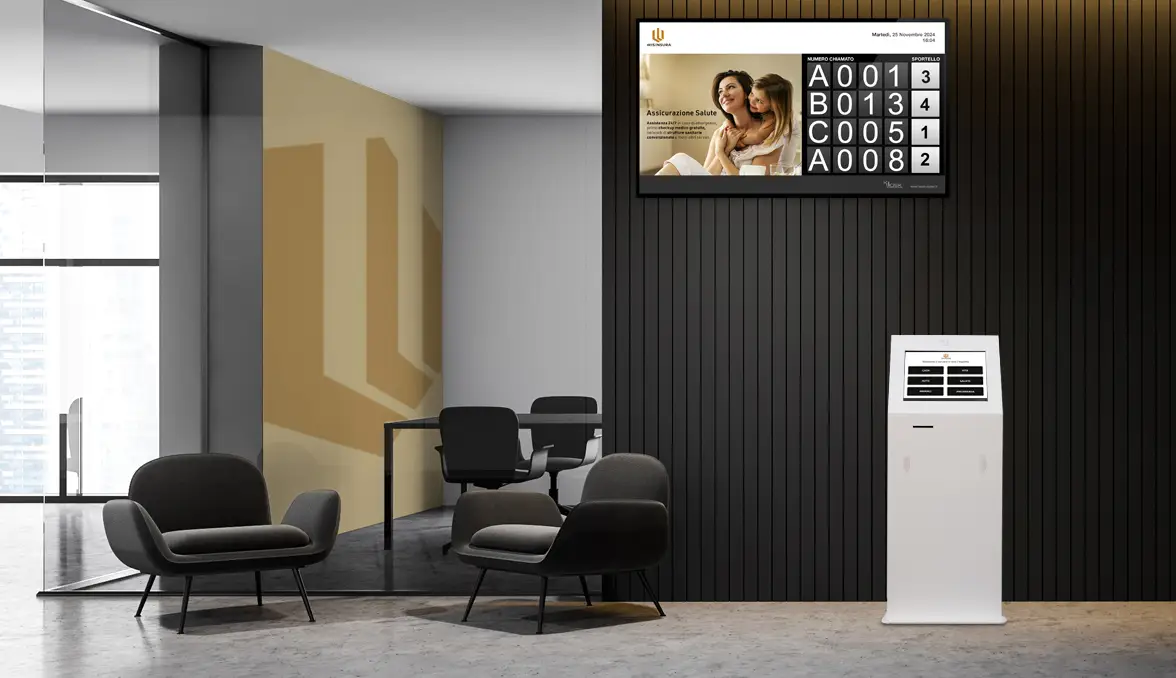Over the years, the concept of waiting has undergone a profound transformation, leading to the spread of queue management systems.
While it was once customary to queue and accept waits in places such as hospitals, public offices or large stores, today customers require a faster and more organised service.
In an increasingly competitive context, store managers, branch managers and customer service managers are faced with a crucial challenge: ensuring reduced waiting times, respecting customer priorities, offering organised and pleasant experiences.
Queue management systems respond to this need, offering a modern and effective solution to improve operational efficiency and customer satisfaction, facilitating the work of all professionals responsible for managing the customer experience.
We talk about it in this article.
Index
- Totems, displays and software: tools for managers who want an efficient service
- Use markets: solutions for each sector
- Selection of the service and Direction to the best consultant
- The problem of poor service and how to avoid it with an advanced queue management system
- Improve the Brand Image and offer a memorable experience
- Increase sales thanks to competent customer service
- Data analysis for strategic customer service
- Conclusion
1 – Totems, displays and software: the essential tools
Sometimes people think that a queue management system is a touch screen totem that emits numbers as a result of a selection on its display.
In reality, it is a set of components that communicate with each other using the network protocol.
Normally, a digital queue management system is made up of 4 fundamental elements:
- Interactive Totems: they allow users to take an electronic ticket and register quickly.
This totem, often placed at the entrance, is intuitive and guides the customer through the process of booking their turn. - Call display: large format displays positioned in strategic points, usually on the ceiling or wall, which show the updated numbers of people waiting and provide important communications, such as the number currently served, the indication of the assigned counter and also, in the most sophisticated ones, scrolling messages and useful information for the service.
The displays eliminate uncertainty, ensuring that each customer knows exactly when their turn will be. - Counter display: visors that indicate the position of the counter and its status, open or closed, for quick identification
- Management software: the heart of the system, which allows you to organize and monitor the flow of customers in real time, optimizing the management of queues and waiting times.
2 – Queue management systems in various markets
When we think of queue management systems, we immediately imagine them in environments such as hospitals and public offices, where waiting times can be long and order requirements are high.
But in a world increasingly focused on customer satisfaction and process efficiency, queue management solutions are proving to be strategic tools for many other sectors.
 From retail to large stores, to banks and restaurants, these systems represent a key resource for improving the customer experience and optimizing operations.
From retail to large stores, to banks and restaurants, these systems represent a key resource for improving the customer experience and optimizing operations.
- Retail and Shopping Centers: where store managers and retail managers face continuous flows of customers and need optimized management to avoid losing sales opportunities and ensure an orderly service.
- Banks, Financial and Insurance Institutions: branch managers can rely on advanced queue management systems to maintain an orderly and organized flow of customers, thus improving the perception of service and increasing customer satisfaction. Integrating a reservation system into queue management not only reduces waiting times, but creates a more peaceful and welcoming environment.Knowing they have an appointment allows customers to feel respected and valued, improving their predisposition.Furthermore, having a reservation allows the consultant to prepare in advance, gathering the necessary information to offer a more personalized and targeted service.
This level of preparation contributes to a kinder and more effective interaction, in which the customer feels understood and welcomed, and the consultant is ready to respond with professionalism and competence.
Result? An improved customer experience that strengthens trust in the Institute and creates the basis for a long-term relationship. - Companies and Corporate Offices: for HR managers or reception managers who want to offer a professional welcome to visitors and employees, ensuring that each guest is handled quickly and compliant with regulations.
- Pharmacies: where customer flows can be intense and irregular, queue management systems help organize the wait, reducing crowding and improving service efficiency. Pharmacists can manage requests in an orderly manner, ensuring personalized assistance and, in the case of customers with specific needs, setting aside the necessary time for detailed advice. This approach improves the perceived quality of the service, reducing waiting times and increasing customer trust and loyalty.
- Car Dealerships: in car dealerships, queue management systems are a fundamental support for managing both customers interested in purchasing a new car and those arriving to collect or service their vehicle. Thanks to these systems, customers can be directed directly to the right sales consultant to receive detailed and personalized information on the cars for sale, while those arriving for assistance or vehicle collection are quickly directed to the desk for the orderly collection of the car and payment for the service.
This system not only reduces, improves organization and avoids friction between waiting customers, but also allows employees to work well and peacefully.
3 – Service selection and directing to the right consultant
One of the great advantages of digital queue management systems is the ability to manage service selection.
Before even contacting an operator, the customer can select the nature of their request via an interactive totem or a specific interface, specifying the type of advice or assistance they need.
In this way, the system automatically directs the customer to the most specialized employee to respond to that specific need.
For example, in a veterinary clinic, a customer who wants nutritional advice will be directed to a veterinarian expert in animal nutrition, while in an emergency they will be put in contact with an emergency room expert.

4 – Effective shift management to offer an efficient service
Let’s imagine a service center that welcomes customers with different needs: those looking for advice on a purchase, those who need technical support and those who want to talk to an expert for specific questions.
Without an advanced system that manages arrival times and directs the customer to the right operator, each of these requests risks being handled by non-specialized personnel, leading to generic responses or a perception of inadequacy.
For example, a customer seeking assistance for a purchase may find themselves interacting with a technician, who perhaps does not have a specific commercial vision and therefore is unable to offer advice oriented to purchasing needs.
Imagine a car dealership, where a customer without a clear point of reference could stop every employee they meet, hoping to find someone who can help them. In these cases, the risk is that the customer receives incomplete or inaccurate information, losing confidence in the service. This approach not only creates frustration, but can also make the dealership appear disorganized.
Similarly, someone looking for technical support could be directed to a sales consultant, who does not have the technical skills to solve the problem.
Thanks to an advanced queue management system, the customer is optimally routed to the ideal expert: a sales consultant to guide them in their purchases, a technician to solve specific problems or a qualified professional to answer in-depth questions.
In this way, each customer receives a personalized and competent response, improving the overall experience and strengthening confidence in the service.
5 – Improve brand image and offer a memorable experience
What makes a truly memorable experience for a customer?
An immediate, comprehensive, kind response, expert guidance and personalized interaction are some of the key elements.
Customers positively remember companies that offer a fast service, oriented to their needs, and perceive added value when they feel listened to and understood.
This type of experience not only builds loyalty, but significantly contributes to strengthening the brand image.
An advanced queue management system, which directs customers to the most suitable consultant, has a direct impact on brand perception, communicating innovation, attention and professionalism. Investing in technologies that optimize service not only improves efficiency but shows the customer that the company is oriented to offering a high-level experience.
Let’s look at some of the many possible examples of how these systems can create positive experiences in different contexts:
- Consulates and Embassies: thanks to multilingual interfaces, queue management systems make it easier for international visitors, directing them to consultants who speak their language.
This simplifies dialogue and makes visitors feel welcomed, facilitating the process and leaving a good impression. - Veterinary and Medical Clinics: for patients seeking specialist care, directing them to a qualified professional is essential. A customer who is efficiently guided to the most competent doctor for their problem feels valued and reassured, which are crucial aspects especially in the healthcare sector.
- Shops and Shopping Centres: in environments where specific advice is required, such as in large electronics stores, directing customers to experts who are knowledgeable about the product of interest can make the difference between a completed purchase and an unsatisfactory visit.
Offering targeted support makes the experience smoother and increases the likelihood of loyalty.
6 – Increase sales thanks to competent customer service
Ensuring the customer has the opportunity to interact with a person who fully understands their needs and is able to respond competently not only improves the overall experience, but can generate a real increase in sales.
A customer who receives qualified and targeted advice feels confident in their decisions and will be more inclined to complete the purchase, often with added value.
When customer service goes beyond simple support, becoming attentive and proactive guidance, it creates trust and reassurance.
This type of approach allows you to:
- Identify the customer’s real needs: actively listening allows the consultant to better understand specific needs and to propose suitable products or services, reducing time and indecision.
- Personalize proposals: a competent consultant knows how to adapt the offer and recommend personalized options, increasing the probability of fully satisfying the customer and improving the perceived value.
- Promote cross-selling and upselling: a positive and informative experience offers the perfect opportunity to suggest complementary products or superior solutions, which the customer is more willing to accept when they perceive a real utility.
For branch managers, store managers and customer service managers, being able to ensure interactions of this level represents not only an opportunity for growth, but a real competitive advantage.
Companies that offer attentive and competent service not only strengthen their brand image, but also stand out in an increasingly customer-oriented market, creating long-term loyalty.
7 – Data analysis for strategic customer service
An innovative aspect of advanced queue management systems is the ability to collect and analyze real-time data on attendance, waiting times and types of requests.
This data provides valuable insights that help branch managers and customer service managers optimize resources and improve operational efficiency.
For example, by observing peaks in traffic and the most requested service areas, it is possible to better plan staff shifts and predict customer needs.
Furthermore, thanks to reporting and monitoring features, companies can quickly identify any critical issues, such as excessive waiting times or overcrowding, taking prompt action to resolve them.
Analyzing the types of service requests can also reveal issues that could be addressed or resolved through updates to the company website.
For example, recurring requests on specific topics could indicate the need to add new information sections, guides or FAQs to facilitate access to information, or report critical issues or malfunctions that would not have been detected otherwise.
In this way, the company can improve its online presence and make the management of requests more efficient, lightening the load on operators.
This data-driven approach therefore not only allows for a more fluid and personalized service, but also contributes to improving the brand image, showing the customer a constant attention to efficiency, quality of service and its commitment to providing clear and accessible information.
8 – Conclusion
Queue management systems represent a strategic investment for branch managers, store managers, customer service managers and customer experience managers.
Solutions such as Kiosk Hydra offer complete and advanced management of queues and reservations, responding to the need not only to reduce waiting times, but also to guarantee a customer-centered service.
With cutting-edge technologies, managers can count on tools that offer control, flexibility and a data-driven vision, to optimize customer flow and continuously improve the experience.
 | Do you want to improve customer experience and optimize customer service?Discover how an advanced queue management system can make a difference for your company, helping you to improve operational efficiency, reduce wait times and offer your customers an organized and personalized experience. |
 |
Vuoi migliorare la customer experience e ottimizzare il customer service?Discover how an advanced queue management system can make a difference for your business, helping you improve operational efficiency, reduce waiting times and offer your customers an organized and personalized experience.
|




